NASA
NASA Reassess Disintegrating 'Larsen B' Ice Shelf in Antarctica; 10,000 Years Old Bridge May be History
| Aishwarya Bhatt | | May 15, 2015 08:25 AM EDT |
The Larsen B ice shelf which started disintegrating in 2002 has worried the NASA scientists once again. The remnant spread in 625 square mile area is 1640 feet thick at its thickest point and has acted as a bridge between glacial ice and the ocean surface for over 10000 years. However, research has pointed out that it is disintegrating at a break neck speed and could be gone in a matter of a few decades.

NASA Plans to Build Oxygen Producing Systems on Mars
| Marco Foronda | | May 15, 2015 04:30 AM EDT |
The organisms would use Mars' ample supply of regolith as fuel, and may even serve a dual purpose in removing nitrogen from the Martian soil.
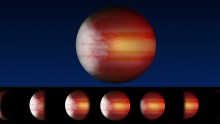
Astronomers Can Now Predict Weather on Distant Planets
| Ana Verayo | | May 14, 2015 11:10 AM EDT |
Data from NASA's Kepler Space Telescope reveals different phases of distant exoplanets for astronomers to create alien world weather forecasts.
New Images of Ceres Determine Bright Spots on Dwarf Planet’s Surface
| Cristian Andal | | May 14, 2015 07:48 AM EDT |
NASA’s Dawn spacecraft has taken what are believed to be the clearest images of Ceres’ surface. The images, taken between May 3 and 4, have revealed that the bright spots are made up of a cluster of smaller spots. What the spots are exactly and what they are made of is still unknown.
Dark Stripes in Europa Rumors as Sea Salt
| Cristian Andal | | May 14, 2015 07:39 AM EDT |
Experiment conducted by NASA on moon Europa suggests that the appearance of mysterious, dark stripes seen on the surface on the moon is possibly a result of sea salt combined with a space full of radiation.

What's the Weather in an Alien Planet?
| Marco Foronda | | May 14, 2015 03:37 AM EDT |
Astronomers studied the weather in exoplanets and observed how they compare to Earth's.
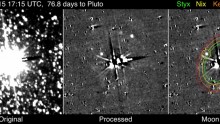
First View of Pluto's Hidden Moons Courtesy of NASA's New Horizons
| Ana Verayo | | May 13, 2015 11:09 AM EDT |
NASA's New Horizons spacecraft is on the verge of reaching Pluto next month and now reveals the first image of two of its hidden moons, Kerberos and Styx.

Squid-Like Rover to Explore Salty Icy Seas of Jupiter's Moon Europa
| Marco Foronda | | May 13, 2015 09:45 AM EDT |
Cornell University researchers proposed to use a squid-like rover to explore Jupiter's moon, Europa in 2020.
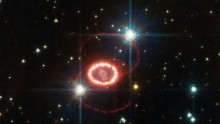
Lopsided Stellar Explosion to Solve Other Supernova Mysteries
| Marco Foronda | | May 13, 2015 05:19 AM EDT |
Recently exploded star had a "lopsided" blast, a feature that could solve supernova mysteries.
NASA Curiosity Rover Captures Mars’ Stunning Sunset
| Cristian Andal | | May 12, 2015 06:02 PM EDT |
The Curiosity rover in Mars has taken spectacular images on the sunset in the red planet. Photographs show blue hues in the horizon. The rover, landed on Mars three years ago. Since then, it continues to send different images back to Earth.
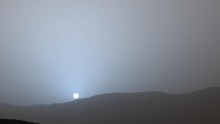
NASA's Mars Rover Captures the Red Planet's Blue Sunset
| Marco Foronda | | May 12, 2015 10:00 AM EDT |
Curiosity has been on Mars for almost three years, but this is the first colored image of a sunset it ever took, using the Mast Cam.

NASA's GL-10 Drone is Both Helicopter and Plane
| Marco Foronda | | May 12, 2015 09:20 AM EDT |
The new prototype vehicle is called Greased Lightning or GL-10. Originally, developed as a drone, but turned into a manned vehicle.
NASA’s Hubble Finds Massive Halo Around Andromeda, Reveals How Galaxies Are Born
| L. P. Cabasag | | May 11, 2015 06:31 PM EDT |
A massive gaseous halo around the Andromeda Galaxy has been discovered by a group of scientists using NASA's Hubble Space Telescope, a discovery that will answer scientists about the giant spiral galaxies and its evolution and structure such as the Milky Way Galaxy and the Andromeda Galaxy.
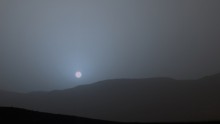
How a Sunset on Mars Looks Like Courtesy of NASA's Curiosity Rover
| Ana Verayo | | May 11, 2015 04:04 AM EDT |
Taken last month, NASA's Curiosity Rover captured images of a sundown on the Red Planet and it's not a red orange sunset we're all used to seeing.

Astronomers Discover Andromeda's Massive Gas Halo, Which Extends Near the Earth
| Marco Foronda | | May 10, 2015 11:05 PM EDT |
Astronomers discover a massive gas halo around Andromeda and is noted to extend near the Earth.
Subscribe to CHINATOPIX !
Sign up for our free weekly newsletter for the latest in-depth coverage!
EDITOR'S PICKS
-

Did the Trump administration just announce plans for a trade war with ‘hostile’ China and Russia?
-

US Senate passes Taiwan travel bill slammed by China
-

As Yan Sihong’s family grieves, here are other Chinese students who went missing abroad. Some have never been found
-

Beijing blasts Western critics who ‘smear China’ with the term sharp power
-

China Envoy Seeks to Defuse Tensions With U.S. as a Trade War Brews
-

Singapore's Deputy PM Provides Bitcoin Vote of Confidence Amid China's Blanket Bans
-

China warns investors over risks in overseas virtual currency trading
-

Chinese government most trustworthy: survey
-

Kashima Antlers On Course For Back-To-Back Titles
MOST POPULAR
LATEST NEWS
Zhou Yongkang: China's Former Security Chief Sentenced to Life in Prison

China's former Chief of the Ministry of Public Security, Zhou Yongkang, has been given a life sentence after he was found guilty of abusing his office, bribery and deliberately ... Full Article
TRENDING STORY

China Pork Prices Expected to Stabilize As The Supplies Recover

Elephone P9000 Smartphone is now on Sale on Amazon India

There's a Big Chance Cliffhangers Won't Still Be Resolved When Grey's Anatomy Season 13 Returns

Supreme Court Ruled on Samsung vs Apple Dispute for Patent Infringement

Microsoft Surface Pro 5 Rumors and Release Date: What is the Latest?



